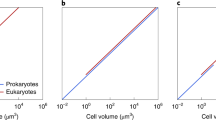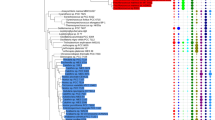Abstract
We observe that the time of appearance of cellular compartmentalization correlates with atmospheric oxygen concentration. To explore this correlation, we predict and characterize the topology of all transmembrane proteins in 19 taxa and correlate differences in topology with historical atmospheric oxygen concentrations. Here we show that transmembrane proteins, individually and as a group, were probably selectively excluding oxygen in ancient ancestral taxa, and that this constraint decreased over time when atmospheric oxygen levels rose. As this constraint decreased, the size and number of communication-related transmembrane proteins increased. We suggest the hypothesis that atmospheric oxygen concentrations affected the timing of the evolution of cellular compartmentalization by constraining the size of domains necessary for communication across membranes.
This is a preview of subscription content, access via your institution
Access options
Subscribe to this journal
Receive 51 print issues and online access
$199.00 per year
only $3.90 per issue
Buy this article
- Purchase on Springer Link
- Instant access to full article PDF
Prices may be subject to local taxes which are calculated during checkout





Similar content being viewed by others
Change history
31 January 2008
The institute in address 2 should have been listed as 'Institute of Molecular Biology and Bioinformatics' and not 'Institute of Molecular Biology and Biochemistry'. This was corrected in the HTML on 31 January 2008.
References
Han, T. M. & Runnegar, B. Macroscopic eukaryotic algae from the 2.1-billion-year-old Negaunee iron-formation, Michigan. Science 257, 232–235 (1992)
Schopf, J. W. & Klein, C. (eds) The Proterozoic Biosphere: a Multidisciplinary Study (Cambridge Univ. Press, New York, 1992)
Knoll, A. H. Proterozoic and early Cambrian protists: evidence for accelerating evolutionary tempo. Proc. Natl Acad. Sci. USA. 91, 6743–6750 (1994)
Ren, Q. & Paulsen, Q. T. Comparative analyses of fundamental differences in membrane transport capabilities in prokaryotes and eukaryotes. PLoS Comp.Biol. 1, e27 (2005)
Kyte, J. & Doolittle, R. F. A simple method for displaying the hydropathic character of a protein. J. Mol. Biol. 157, 105–132 (1982)
von Heijne, G. Net N–C charge imbalance may be important for signal sequence function in bacteria. J. Mol. Biol. 192, 287–290 (1986)
Sipos, L. & von Heijne, G. Predicting the topology of eukaryotic membrane proteins. Eur. J. Biochem. 213, 1333–1340 (1993)
von Heijne, G. Membrane protein structure prediction. Hydrophobicity analysis and the positive-inside rules. J. Mol. Biol. 225, 487–494 (1992)
Tourasse, N. J. & Li, W. H. Selective constraints, amino acid composition, and the rate of protein evolution. Mol. Biol. Evol. 17, 656–664 (2000)
Mazel, D. & Marlière, P. Adaptive eradication of methionine and cysteine from cyanobacterial light-harvesting proteins. Nature 341, 245–248 (1989)
Baudouin-Cornu, P., Surdin-Kerjan, Y., Marlière, P. & Thomas, D. Molecular evolution of protein atomic composition. Science 293, 297–300 (2001)
Baudouin-Cornu, P., Schuerer, K., Marlière, P. & Thomas, D. Intimate evolution of Proteins. Proteome atomic content correlates with genome base composition. J. Biol. Chem. 279, 5421–5428 (2004)
Elser, J. J., Fagan, W. F., Subramanian, S. & Kumar, S. Signatures of ecological resource availability in the animal and plant proteomes. Mol. Biol. Evol. 23, 1946–1951 (2006)
Elser, J. J. et al. Biological stoichiometry from genes to ecosystems. Ecol. Lett. 3, 540–550 (2000)
Kay, A. D. et al. Toward a stoichiometric framework for evolutionary biology. Oikos 109, 6–17 (2005)
Hasenfuss, I. A possible evolutionary pathway to insect flight starting from lepismatid organization. J. Zool. Syst. Evol. Res. 40, 65–81 (2002)
Elser, J. J., Watts, J., Schampel, J. H. & Farmer, J. Early Cambrian food webs on a trophic knife-edge? A hypothesis and preliminary data from a modern stromatolite-based ecosystem. Ecol. Lett. 9, 295–303 (2006)
Knoll, A. H. Life on a Young Planet: The First Three Billion Years of Evolution on Earth (Princeton Univ. Press, Princeton and Oxford, 2003)
Berner, R. A. Atmospheric oxygen over Phanerozoic time. Proc. Natl Acad. Sci. USA. 96, 10955–10957 (1999)
Krogh, A., Larsson, B., von Heijne, G. & Sonnhammer, E. L. Predicting transmembrane protein topology with a hidden Markov model: application to complete genomes. J. Mol. Biol. 305, 567–580 (2001)
Stevens, T. J. & Arkin, I. T. Do more complex organisms have a greater proportion of membrane proteins in their genomes?. Proteins 39, 417–420 (2000)
Wallin, E. & von Heijne, G. Genome-wide analysis of integral membrane proteins from eubacterial, archaean, and eukaryotic organisms. Protein Sci. 7, 1029–1038 (1998)
Liò, P. & Vannucci, M. Investigating the evolution and structure of chemokine receptors. Gene 317, 29–37 (2003)
Aitchison, J. The Statistical Analysis of Compositional Data 154–155 (Chapman and Hall, London, 1986)
Tamames, J., Ouzounis, C., Sander, C. & Valencia, A. Genomes with distinct function composition. FEBS Lett. 389, 96–101 (1996)
Liu, J. & Rost, B. Comparing function and structure between entire proteomes. Protein Sci. 10, 1970–1979 (2001)
Akashi, H. & Gojobori, T. Metabolic efficiency and amino acid composition in the proteomes of Escherichia coli and Bacillus subtilis.. Proc. Natl Acad. Sci. USA. 99, 3695–3700 (2002)
Raymond, J. & Segre, D. The effect of oxygen on biochemical networks and the evolution of complex life. Science 311, 1764–1767 (2006)
Hedges, S. B., Blair, J. E., Venturi, M. L. & Shoe, J. L. A molecular timescale of eukaryote evolution and the rise of complex multicellular life. BMC Evol. Biol. 4, 2 (2004)
Martin, W. et al. Early cell evolution, eukaryotes, anoxia, sulfide, oxygen, fungi first (?), and a tree of genomes revisited. IUBMB Life 55, 193–204 (2003)
Douzery, E. J. P., Snell, E. A., Bapteste, E., Delsuc, F. & Philippe, H. The timing of eukaryotic evolution: does a relaxed molecular clock reconcile proteins and fossils?. Proc. Natl Acad. Sci. USA. 101, 15386–15391 (2004)
Sheridan, P. P., Freeman, K. H. & Brenchley, J. E. Estimated minimal divergence times of the major bacterial and archaeal phyla. Geomicrobiol. J. 20, 1–14 (2003)
Hedges, S. B. The origin and evolution of model organisms. Nature Rev. Genet. 3, 838–849 (2002)
Anderson, J. S. & Sues, H.-D. (eds) Major Transitions in Vertebrate Evolution (Indiana Univ. Press, Bloomington and Indianapolis, in the press).
Acknowledgements
The authors would like to thank J. Anderson for help with the estimates of the time of appearance of the organisms used for this study, and D. Schomburg, R. Wünschiers, D. Bauer, A. Scialpi, M. Koornneef, H. Hillebrand, A. M. Tarchi, P. Bruni, T. Wiehe, B. Haubold and T. Rothery for valuable discussions. Author Contributions C.A. initiated and devised the project; C.A., S.C. and J.K. analysed the data; and S.C. and C.A. wrote the manuscript.
Author information
Authors and Affiliations
Corresponding author
Ethics declarations
Competing interests
Reprints and permissions information is available at www.nature.com/reprints. The authors declare no competing financial interests.
Supplementary information
Supplementary Information
This file contains Supplementary Table showing organisms names and data sets sample sizes and Supplementary Figures 1- 7 with legends. (PDF 2115 kb)
Rights and permissions
About this article
Cite this article
Acquisti, C., Kleffe, J. & Collins, S. Oxygen content of transmembrane proteins over macroevolutionary time scales. Nature 445, 47–52 (2007). https://doi.org/10.1038/nature05450
Received:
Accepted:
Published:
Issue Date:
DOI: https://doi.org/10.1038/nature05450
This article is cited by
-
Subcellular stoichiogenomics reveal cell evolution and electrostatic interaction mechanisms in cytoskeleton
BMC Genomics (2018)
-
GRASP [Genomic Resource Access for Stoichioproteomics]: comparative explorations of the atomic content of 12 Drosophila proteomes
BMC Genomics (2013)
-
Mapping of the minimal inorganic phosphate transporting unit of human PiT2 suggests a structure universal to PiT-related proteins from all kingdoms of life
BMC Biochemistry (2011)
-
The evolutionary consequences of oxygenic photosynthesis: a body size perspective
Photosynthesis Research (2011)
-
A Review of metabolic staging in severely injured patients
Scandinavian Journal of Trauma, Resuscitation and Emergency Medicine (2010)
Comments
By submitting a comment you agree to abide by our Terms and Community Guidelines. If you find something abusive or that does not comply with our terms or guidelines please flag it as inappropriate.



